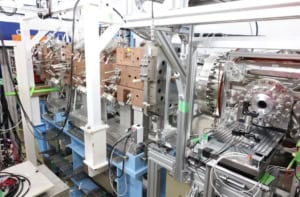Mark Levinson is a film director whose most recent film, Particle Fever, was about the discovery of the Higgs boson. In this interview, he talks to Margaret Harris about why he left physics research and how his latest project helped him reconnect with his roots

How did you get interested in physics?
I actually really disliked physics in high school, but I was good at mathematics and science, so I thought my dislike of physics might be something I could recover from. Then when I went to university, I had an incredible physics teacher who showed me the beauty of it. What attracted me was the fact that we have this human invention called mathematics, and somehow it correlates with the real world. I still find that extremely profound. In some sense, it’s the greatest mystery of all, and it’s why I became a theorist. I did my PhD in particle physics with Geoffrey Chew at the University of California, Berkeley, and I was a sort of “physics groupie” – in my spare time I was reading biographies of Dirac and other great physicists as well as learning about quantum field theory and the Higgs boson.
Did you ever think about continuing in physics?
I thought about it, but the early 1980s was not a great time for theorists in particle physics. We had all these theories, but we weren’t sure what experiments were going to be built that could actually test them. There also weren’t a lot of jobs available. But what led me away from physics wasn’t disillusionment – it was more that I had developed this other passion as well, for film.
How did you become interested in film?
I was always interested in it in a populist kind of way, but it wasn’t until I was an undergraduate that I became aware of European film and started seeing cinema as a medium that could be serious and surprisingly deep. Then when I was at Berkeley, I lived in an in-law apartment with this older lefty couple who were real cineastes, and that’s when I realized that people actually make movies – they don’t just emanate from Hollywood fully formed. I found Eastern European cinema particularly fascinating. It was amazing that these directors, who often worked under very restrictive political conditions, were making remarkable films with depth and complexity that revealed something profound about human existence.
How did you get into filmmaking as a career?
I started out by writing a script, which was almost like being a theorist: I went from sitting in my room by myself with a paper and a pencil, coming up with a theory of the world and not getting paid much, to writing a script in pretty much the same conditions. When I realized I needed to learn more practical skills, I answered an ad for an intern in a local production. I worked on a variety of things – location scouting, art department, craft services and so on – and afterwards I became an assistant in the edit room. Gradually I began to specialize in working with actors in post-production to fix and add lines. That area of filmmaking is called ADR, and it became my “day job” while I was working on my script and shooting my first film, which was about a fictional painter and writer in Eastern Europe trying to adapt to the changes of glasnost.
How did you get involved with Particle Fever?
I had always thought I might do something about science in order to justify the fact that I started my film career with a physics PhD. Then some investors told me about a physicist, David Kaplan, who had presented them with a proposal for a documentary about an experiment that might not work, and even if it did, it might not find anything. They thought it was a bad idea, but of course I thought it sounded great. So I contacted David and told him that although I wasn’t interested in doing a traditional, informational physics documentary, if we could make it into something that was character-driven, where I could use my narrative storytelling techniques, I would be really excited. He was all for that as well, so that’s how we got started.
What was your favourite part about making the film?
My favourite part of any project is finishing it, but when I think back on the process, I really enjoyed working with the physicists in Particle Fever, because it meant I was in that world again. It was really satisfying to reconnect with my feelings about physics. Also, on a dramatic film, the period when you actually get to interact with actors is relatively short, but with Particle Fever I got to work with the physicists for five years, and that was very rewarding.
Any advice for today’s physics students?
Follow your passion. Physics is an incredible endeavour and like anything worth doing, it’s hard, with a lot of frustration, but the rewards are great. Ironically, I think I’d give the same advice to filmmakers. In both physics and filmmaking, you don’t know what’s going to happen, but if you really love it and you’re committed to it, then I think it leads to a very worthwhile life. When I gave a talk to some students recently, they asked me what I thought the best thing was about being a physicist, and I told them you get paid to think about the mysteries of the universe. That’s a pretty good gig.



